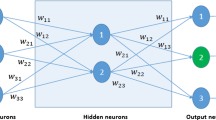Abstract
When using neural networks to train a large number of data for classification, there generally exists a learning complexity problem. In this paper, a new geometrical interpretation of McCulloch-Pitts (M–P) neural model is presented. Based on the interpretation, a new constructive learning approach is discussed. Experimental results show that the new algorithm can greatly reduce the learning complexity and can be applied to real classification problems with a vast amount of data.
Supported by National Nature Science Foundation & National Basic Research Program of China
Preview
Unable to display preview. Download preview PDF.
Similar content being viewed by others
References
McCulloch, W. S. and Pitts, W.: A logical calculus of the ideas immanent in neurons activity, Bulletin of Mathematical Biophysics, 5 (1943) 115–133
Cooper, P. W.: A note on adaptive hypersphere decision boundary, IEEE Transactions on Electronic Computers (1996) 948–949
Roy, A. and Mukhopadhyay, S.: Pattern classification using linear programming, ORSA Journal on Computer, 3(1) (1991) 66–80
Mukhopadhyay, S., Roy, A., Kim, L. S. and Govil, S.: A polynomial time algorithm for generating neural networks for pattern classification: Its stability properties and some test results, Neural Computation, 5(2) (1993) 317–330
Musavi, M. T. M., Ahmed, W., Chan, K. H., Faris, K. B. and Hummels, D. M.: On the training of radial basis function classifiers, Neural Networks, vol.5 (1992) 593–603
Lee, S. and Kil, R.: Multilayer feedforward potential function network,” in Proc. of the IEEE Second International Conference on Neural Networks, San Diego IEEE, New York (1988) 161–171
Reilly, D. L. and Cooper, L. N.: An overview of neural networks: early models to real world systems, in An Introduction to Neural and Electronic Networks, Zornetzer, S. F., Davis, J. L. and Lau, C. (eds.) Academic Press San Diego (1990) 227–246
Abe, S and Lan, M. S.: A method for fuzzy rules extraction directly from numerical data and its application to pattern classification, IEEE Transactions on Fuzzy Systems, vol.3no.1 (1995) 18–28.
Abe, S. and Thawonmas, R.: A fuzzy classifier with ellipsoidal regions, IEEE Trans. on Fuzzy Systems, vol.5no.3 (1997) 358–368
Fahlman, S. E. and Lebiere, C.: The cascade-correlation learning architecture, In Tourdtzhy, D. S. (ed.), Advances in Neural Information Processing Systems, 2, San Mateo, CA, Morgan Kaufmann, (1990) 524–532
Lang, K. J. and Witbrock, M. L.: Learning to tell two spirals apart, in Proc. of the 1988 Connectionists Models Summer Schools (Pittsburgh, 1988), Touretzky, D., Hinton, G. and Sejnowski, T. (eds.) Morgan Kaufmann, San Mateo, CA (1988) 52–59
Hassoun, M. H.: Fundamentals of Artificial Neural Networks, MIT Press, Cambridge, Massachusetts (1995)
Baum, E. B. and Lang, K. J.: Constructing hidden units using examples and queries, In Lippman, R. P., et al (eds.): Neural Information Processing Systems, 3 San Mateo, CA: Morgan Kaufmann (1991) 904–910
Chen, Q. C., et. al.: Generating-shrinking algorithm for learning arbitrary classification, Neural Networks, 7 (1994) 1477–1489
Roberts, F. S.: Applied Combinatorics, Prentice-Hall, Inc. (1984)
Hong, J. R.: AE1, An extension matrix approximate method for the general covering problem, Int. J. of Computer and Information Science, 14(6) (1985) 421–437
Author information
Authors and Affiliations
Editor information
Editors and Affiliations
Rights and permissions
Copyright information
© 1999 Springer-Verlag Berlin Heidelberg
About this paper
Cite this paper
Zhang, L., Zhang, B. (1999). Neural Network Based Classifiers for a Vast Amount of Data. In: Zhong, N., Zhou, L. (eds) Methodologies for Knowledge Discovery and Data Mining. PAKDD 1999. Lecture Notes in Computer Science(), vol 1574. Springer, Berlin, Heidelberg. https://doi.org/10.1007/3-540-48912-6_32
Download citation
DOI: https://doi.org/10.1007/3-540-48912-6_32
Published:
Publisher Name: Springer, Berlin, Heidelberg
Print ISBN: 978-3-540-65866-5
Online ISBN: 978-3-540-48912-2
eBook Packages: Springer Book Archive




